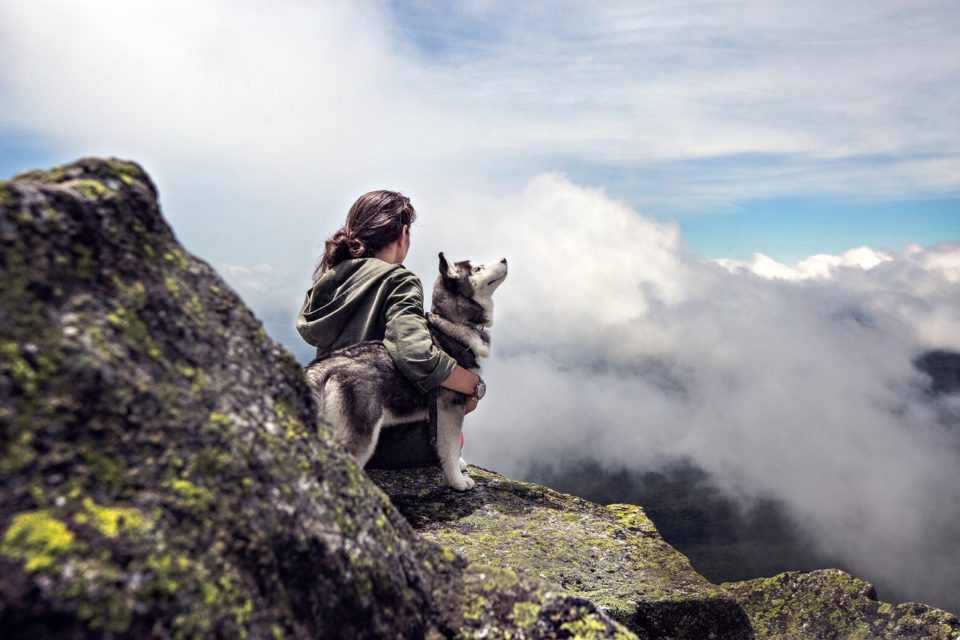Hi, my name’s Irena. I live on the beautiful island of Crete in Greece, and I have had a lot of dogs in my time here.
Currently I have four, Sherlock, Lipstick, Aphrodite, and Oliver. Three are the grand old age of fourteen and a half, and one’s just four.
The youngest is a little terror, but I wouldn’t be without him.
None of my dogs are pure bred, but that doesn’t matter. I love them just as much as if they were.
Huskies are in fact one of my favorite breeds. When I went to Lapland in 2004, I went on a sled ride pulled by Huskies.
Their speed was amazing and they seemed to love doing the job. It was an exhilarating experience and I would love to do it again.
Samoyed’s are also great dogs and do have a lot of similarities to Huskies, not least being the fact that they both originated in very cold climates.
This article will tell you all about both breeds and I hope that you will discover two very enticing types of dogs.
A Brief Differences and Comparison
Huskies and Samoyeds have plenty in common. They are very similar in size and both have thick coats, although that of a Samoyed may be even heavier.
Both the Samoyed and Husky originated in Siberia and were used as sled dogs. Either makes a great family pet as they have friendly and loyal personalities.
However, there are a few differences. Samoyeds are keen to please their owners and are very easy to train.
Huskies also like to please, but their personalities are a little more independent than the Samoyed.
You could say that they have their own mind and if they don’t want to do something it’s very difficult to move them.
Due to this they need to be trained from an early age and you do need to be strict with them otherwise they can run riot.
Husky vs Samoyed: Overview of Huskies
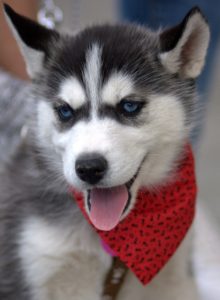
I love the way Huskies look especially their blue eyes. Some even have different colored eyes which I think is totally amazing.
Forget about brown colored eyes for a while and concentrate on something totally different.
Huskies were developed in the isolated Yakutsk region of extreme northeastern Siberia by the semi nomadic Chukchi people.
Huskies were capable of travelling long distances pulling laden sleds as well as people.
Huskies were imported to Alaska in 1909 where they took part in sled racing and were used to carry medication when a severe diphtheria epidemic swept the area of Nome.
The great things about Huskies is that they are independent, affectionate, and intelligent.
Train them well and they will interact brilliantly with your whole family as well as strangers.
If you are looking for a watchdog, Huskies aren’t the right choice. They don’t bark much so you won’t get much warning of an intruder.
However, they do occasionally howl like a wolf, another reason why I want one!
Husky vs Samoyed: Overview of Samoyeds
Samoyeds are beautiful, hardworking, practical dogs. They originated guarding reindeer flocks, pulling sleds, and keeping people warm on the Siberian tundra.
They still suit cold temperatures much more so than warm.
They are intelligent dogs and can easily be trained for obedience, much more so than Huskies.
They bond easily with their family so indoors is the best place for them to be, although a fenced yard is a great supplement for exercise.
Samoyeds have thick coats meaning that they thrive in cold temperatures.
They can cope with a temperate climate, although if you do decide to keep Samoyeds in a warmer climate, make sure that you don’t leave them alone outside where they can overheat.
Husky vs Samoyed Size: Which is Bigger?
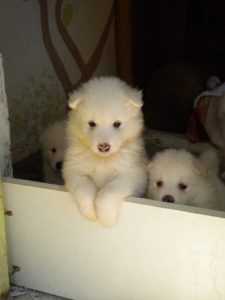 A Husky is just a little bigger than a Samoyed, but the difference is so small and they are basically both medium sized dogs.
A Husky is just a little bigger than a Samoyed, but the difference is so small and they are basically both medium sized dogs.
Male Samoyeds stand at 21 – 23.5 inches, while male Huskies are 21 – 24 inches. Female Samoyeds are 19 – 21 inches, while female Huskies are 19 – 23 inches.
When it comes to weight, Samoyeds are a little heavier than Huskies. Males weigh in at 45 – 65 pounds, while male Huskies are just 44 – 60 pounds.
Female Samoyeds are similar in weight to female Huskies. They weigh 35 – 50 pounds, while female Huskies are just 35 – 51 pounds.
Husky vs Samoyed Temperament: How Do They Behave?
Samoyeds are keen to be tasked and to please their owners. Once you have established yourself as the pack leader, then it is easy to train them.
Samoyeds need human interaction otherwise they can develop destructive habits such as digging, barking, and chewing the hairs off their legs.
I have a dog just like that, Sherlock. He’s not a Samoyed, but I can fully understand the frustration a Samoyed owner can have if he comes to a home which has been turned upside down.
Sherlock even destroyed the couch when he was a pup!
Samoyeds enjoy barking, but once they are acknowledged by their owners, they will keep quiet as they then feel secure.
These dogs are social and shouldn’t be left alone outdoors for a long period of time. They will play excitedly outside especially if they have human companionship, but indoors they will remain calm.
A fun fact about Samoyeds is that because they love to herd they can even start herding children, not a bad idea if you want all your children in one place.
However, it can be inconvenient so try and train this out of them at an early age.
Huskies are mischievous and they can run circles around you if you let them. Just like Samoyeds, they get bored if left alone for hours on end and they can start to destroy your home.
Get another Husky. They will keep each other company and play for hours on end.
Another way to keep Huskies amused is when you are at home; exercise them to their hearts content. Then they’ll rest when you’re not there. Walks aren’t enough.
Run with them, take them for hikes, and play fetch. Let them run round the yard, but make sure you have a secure fence as Huskies are little devils. They’ll escape just for fun.
Huskies are very smart dogs, but they have their own minds and won’t blindly follow commands. If you want to find out how smart huskies are check out this article!
Samoyeds are much more obedient. However, start training Huskies early and the chances are that you will get well behaved dogs.
Husky vs Samoyed Life Span: What’s Their Life Expectancy?
Huskies can live a little longer than Samoyeds, 12 – 14 years in comparison to 10 – 12 years for Samoyeds.
There seems to be no rhyme or reason for this as they are similar sized. In general, larger dogs don’t have such a long life span as smaller dogs.
Husky vs Samoyed: Are They Prone to Health Conditions?
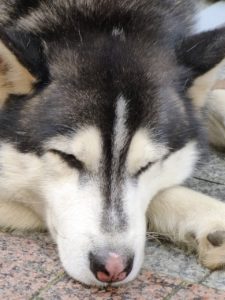 Unfortunately both Samoyeds and Huskies can suffer from various health conditions, but then it would be a perfect world if they didn’t.
Unfortunately both Samoyeds and Huskies can suffer from various health conditions, but then it would be a perfect world if they didn’t.
It is good to know however, that Huskies are less prone to illnesses than a lot of other breeds. Even Samoyeds have more health problems than Huskies.
One thing the two breeds have in common is hip dysplasia. This is a very painful disease and involves the abnormal formation of the hip socket which can lead to lameness and even arthritis of the joints.
Strenuous exercise such as climbing stairs can make hip dysplasia worse. Make sure that your dogs are taking it easy if they have this illness, not an enviable task with such boisterous dogs.
Hip dysplasia can even be passed on from parent dogs.
Problems with eyes is another issue which can affect both Huskies and Samoyeds.
Huskies can get cataracts from as young as three months which of course is very worrying as not only can they cause poor eyesight, but blindness.
Both Samoyeds and Huskies can suffer from progressive retinal atrophy which can again cause blindness.
Eye problems shouldn’t be taken lightly with either breed and vet visits should be arranged if you are at all worried.
Samoyeds can get bloat easily. It is an unpleasant disease as the stomach fills with gas and fluid and then rotates on itself.
It can be deadly very quickly so try and make sure that your dogs don’t eat too quickly. Huskies are very picky eaters so bloat is less likely.
In addition, Samoyeds can develop hereditary glomerulopathy, a disorder linked to genetic mutation which can result in kidney failure even with a dog as young as 15 months.
Pulmonic stenosis, which can cause heart failure, can also be an issue.
Husky vs Samoyed Appearance: What do They Look Like?
As I’ve already said, Huskies often have blue eyes or even two different colored eyes. They are always almond shaped.
They can certainly hold you in a long stare and I can’t see myself looking elsewhere if they want to engage me in a staring competition.
Huskies have medium sized heads and their ears stand erect. They are often black and white in color, though browns and creams are also common.
Samoyeds are slightly longer than tall. They are white, cream, biscuit colored, or white and cream. Sometimes they even seem to have an icy sheen.
They have a foxy looking face with dark brown or black almond-shaped eyes and erect ears. They always look as if they are smiling which I find to be a very enticing factor.
Husky vs Samoyed Shedding: What Kind of Coats Do They Have?
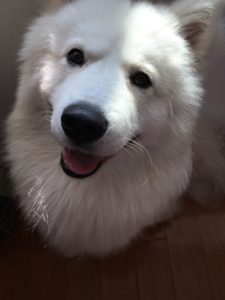 Both Huskies and Samoyeds have thick, double layer, water repelling coats. They do shed all year round, and they blow-coat seasonally to keep their coats in good condition.
Both Huskies and Samoyeds have thick, double layer, water repelling coats. They do shed all year round, and they blow-coat seasonally to keep their coats in good condition.
This happens twice a year and they should be bathed at this time. Bathing is not necessary at other times as they are both self-grooming breeds.
I know, I know, bathing your Huskies or Samoyeds won’t fill you with delight.
There’ll probably be more water all over the floor and over you than the, but it is necessary to stop the shedding.
Husky vs Samoyed Grooming: How Much Do They Require?
Huskies and Samoyeds need less grooming than many other double-coated dogs. Just aim to brush once a week in normal conditions.
Both breeds should have their teeth regularly checked for tartar and they should be cleaned often.
It’s not fun for older dogs to chew their food with gums rather than teeth.
In addition, check their ears for signs of wax build-up or dirt. If they can’t hear you they won’t be able to obey your commands.
Husky vs Samoyed Training: Can They be Trained Easily?
Huskies aren’t the easiest dogs to train and in that case might not be the best dog for a new dog owner.
However, if you are a strong person and feel that you can give them commands and take no nonsense back, you will be rewarded by lovely pets.
My Sherlock has exactly the same issues and I’m sure he was a Husky in a former life!
Once you get your Husky puppies, start training them immediately. A puppy is so much easier to train than an adult dog.
Teach them to walk to heel, to be comfortable in a crate, and to not be destructive.
Of course you have to do your part as well. Don’t expect your Huskies to be non-destructive if you don’t give them enough exercise or toys to play with while you are not at home.
Samoyeds on the other hand, are much easier to train. They want to please their master and are never happier if their owners are content.
Husky vs Samoyed Availability: Are They a Rare Dog Breed?
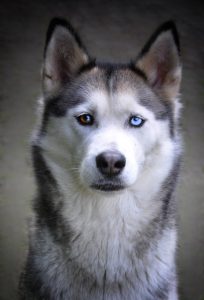 Neither Huskies nor Samoyeds are difficult to purchase in colder climates, but you might not be so lucky in warmer areas.
Neither Huskies nor Samoyeds are difficult to purchase in colder climates, but you might not be so lucky in warmer areas.
They don’t suit hot climates due to their coat and it isn’t fair to bring up a dog in an unsuitable climate.
Samoyed puppies are a little more expensive than Huskies, ranging from $775 – $1700, while Huskies are $450 – $1500.
Always look to buy one of these puppies from a reputable dog breeder.
Husky vs Samoyed Family Dog: Are They Good with Children?
Samoyeds are soft and gentle big love-bugs. They love to play and are ideal with children.
This isn’t to say that Huskies aren’t affectionate with children because they are.
They love being part of a big family. The more the merrier and the human pack is just as important as the dog pack to them.
However, while Samoyeds are gentle beasts Huskies can play a bit rough. Don’t leave them alone with young children.
They won’t mean it, but they could unintentionally hurt your child.
Husky vs. Samoyed Food: How to Feed Your Dog?
Neither Huskies nor Samoyeds are big eaters.
This is due to the fact that they were used to pull sleds for long distances on a minimum of amount of food. They could even go for days without eating.
To encourage both breeds of puppies to eat, try adding meat juices or bacon grease to their food. The smell should entice their little taste buds to open up.
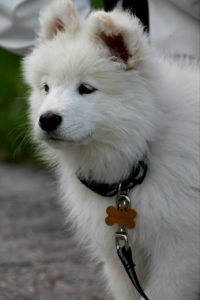
As with any dog, overfeeding is not recommended.
Samoyeds and Huskies don’t need much food to fill them up and if they start to put on weight, their lifespans can be reduced drastically.
Boredom puts Huskies and Samoyeds off food. In addition, if a food makes them sick they won’t eat it again.
Husky vs Samoyed Living Conditions: Where are They Best Suited?
Huskies and Samoyeds can live in apartments, but they both fare better in a house where they have a garden to run about in.
Huskies and Samoyeds both do well in cold temperatures between -70F and 65F.
Husky vs Samoyed Running Costs: Are They Expensive to Look After?
Neither Huskies nor Samoyeds are particularly expensive to maintain.
For a start, they’re not big eaters so your food costs won’t be exorbitant.
Secondly, they can easily be groomed at home so you won’t have expensive grooming bills.
Final Thoughts
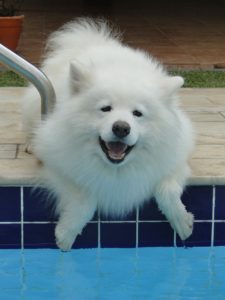 Both Samoyeds and Huskies are great dogs to own. They are high energy work dogs who bounce and pounce everywhere and require lots of exercise.
Both Samoyeds and Huskies are great dogs to own. They are high energy work dogs who bounce and pounce everywhere and require lots of exercise.
However, there are a few differences between the two dogs.
Samoyeds are a little more easily trainable as they are eager to please.
Huskies are a slightly more stubborn and need a firm hand. Both can be destructive however if left with little to do for long periods of time.
They are both highly intelligent and need to be stimulated.
Although both breeds originated in the cold of Siberia and prefer lower temperatures, Samoyeds are considered to be herding dogs, while Huskies are an endurance racing breed.
They can in fact even run up to 100 miles a day. Pretty amazing isn’t it?
If you are looking for a challenge but one which comes wrapped up with lots of love you won’t go far wrong in choosing either a Husky or a Samoyed.
